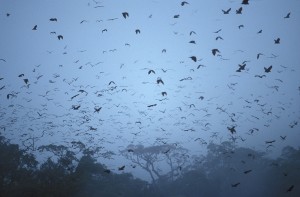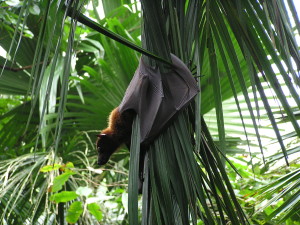It’s Halloween time again, and around much of the world people are decorating with images of ghosts, vampires, witches, black cats, and, of course, bats.
For the superstitious, there may be nothing scarier than the flying foxes of the Philippines, whose 2-meter wingspans make them the largest bats in the world!
In keeping with the near-global fear and mistrust of nocturnal animals, Philippine flying foxes (fruit bats) are linked with many of the eerie spirits that haunt their nights.
Most closely resembling a flying fox is Manananggal (left). This aswang (Filipino for vampire-like creatures) is a woman by day, but at night her torso detaches in the middle. The upper half grows bat wings allowing her to fly through the night in search of her preferred source of nourishment: the unborn fetus. According to the myth, Manananggal lands on the roof of a home and drops her long, needle-thin tongue into the belly of a pregnant woman in her sleep.
This evil, mythological creature shares the distribution of flying foxes in Southeast Asia under the monikers Manananggal (Philippines); Pennangalan (Malay); Leyak (Balinese); Kuyang (Dayak); Palasik (Indonesia); Krasue (Thai); Kasu or Phi-Kasu (Lao), Ab (Khmer).
Although not as explicit as Manananggal, most aswang in the Philippines have characteristics of flying foxes. Tik-tik and Wak-wak are similar to Manananggal, but said to be black birds and are named, respectively, for their “tik-tik” nocturnal calls and the “wak-wak” sound of airy flapping wings, both of which are recognizable sounds made by flying foxes at night. Tiyanak is in the form of a human baby, but has fangs and sharp claws and flies away as a black bird. Capre and Tikbalang take on different animal forms, yet are found in fig trees at night with red reflective eyes like fruit bats.
However, not all myths about flying foxes are negative. Across their wide distribution, flying fox meat is believed to be distinctively clean and nutritious with medicinal properties supporting the elderly and people with asthma and other respiratory illnesses.
In addition, scientific research has shown these amazing creatures are vital to human survival. As pollinators and seed dispersers, flying foxes are essential for maintaining natural forests, often the only source of fresh water, air, and timber and non-timber forest products. Flying foxes are also known to pollinate hundreds of agriculturally important crops for the region.
http://www.sospecies.org/sos_projects/mammals/filipinos_for_flying_foxes/



